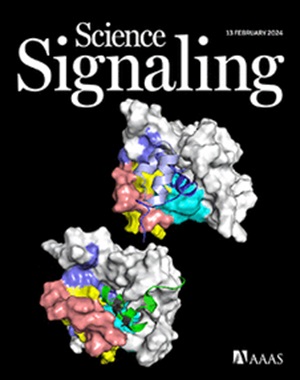Extracellular proximal interaction profiling by cell surface–targeted TurboID reveals LDLR as a partner of liganded EGFR
IF 6.7
1区 生物学
Q1 BIOCHEMISTRY & MOLECULAR BIOLOGY
引用次数: 0
Abstract
Plasma membrane proteins play pivotal roles in receiving and transducing signals from other cells and from the environment and are vital for cellular functionality. Enzyme-based, proximity-dependent approaches, such as biotin identification (BioID), combined with mass spectrometry have begun to illuminate the landscape of proximal protein interactions within intracellular compartments. To extend the potential of these approaches to study the extracellular environment, we developed extracellular TurboID (ecTurboID), a method designed to profile the interactions between proteins on the surfaces of living cells over short timescales using the fast-acting biotin ligase TurboID. After optimizing our experimental and data analysis strategies to capture extracellular proximity interactions, we used ecTurboID to reveal the proximal interactomes of several plasma membrane proteins, including the epidermal growth factor receptor (EGFR). We found that EGF stimulation induced an association between EGFR and the low-density lipoprotein receptor (LDLR) and changed the interactome of LDLR by increasing its proximity with proteins that regulate EGFR signaling. The identification of this interaction between two well-studied and clinically relevant receptors illustrates the utility of our modified proximity labeling methodology for identifying dynamic extracellular associations between plasma membrane proteins.
通过细胞表面靶向 TurboID 进行细胞外近端相互作用分析,发现 LDLR 是配体表皮生长因子受体的伙伴。
质膜蛋白在接收和传递来自其他细胞和环境的信号方面起着关键作用,对细胞功能至关重要。生物素鉴定(BioID)等基于酶的近距离依赖性方法与质谱技术相结合,已开始揭示细胞内区室中近距离蛋白质相互作用的全貌。为了将这些方法的潜力扩展到细胞外环境的研究中,我们开发了细胞外 TurboID(ecTurboID),这是一种利用快速生物素连接酶 TurboID 在短时间内分析活细胞表面蛋白质之间相互作用的方法。在优化实验和数据分析策略以捕捉细胞外近距离相互作用之后,我们利用 ecTurboID 揭示了包括表皮生长因子受体(EGFR)在内的几种质膜蛋白的近距离相互作用组。我们发现表皮生长因子受体的刺激会诱导表皮生长因子受体与低密度脂蛋白受体(LDLR)之间的关联,并通过增加 LDLR 与调控表皮生长因子受体信号转导的蛋白之间的接近度来改变 LDLR 的相互作用组。在两种经过充分研究并与临床相关的受体之间发现这种相互作用说明了我们改进的接近性标记方法在鉴定质膜蛋白之间动态细胞外关联方面的实用性。
本文章由计算机程序翻译,如有差异,请以英文原文为准。
求助全文
约1分钟内获得全文
求助全文
来源期刊

Science Signaling
BIOCHEMISTRY & MOLECULAR BIOLOGY-CELL BIOLOGY
CiteScore
9.50
自引率
0.00%
发文量
148
审稿时长
3-8 weeks
期刊介绍:
"Science Signaling" is a reputable, peer-reviewed journal dedicated to the exploration of cell communication mechanisms, offering a comprehensive view of the intricate processes that govern cellular regulation. This journal, published weekly online by the American Association for the Advancement of Science (AAAS), is a go-to resource for the latest research in cell signaling and its various facets.
The journal's scope encompasses a broad range of topics, including the study of signaling networks, synthetic biology, systems biology, and the application of these findings in drug discovery. It also delves into the computational and modeling aspects of regulatory pathways, providing insights into how cells communicate and respond to their environment.
In addition to publishing full-length articles that report on groundbreaking research, "Science Signaling" also features reviews that synthesize current knowledge in the field, focus articles that highlight specific areas of interest, and editor-written highlights that draw attention to particularly significant studies. This mix of content ensures that the journal serves as a valuable resource for both researchers and professionals looking to stay abreast of the latest advancements in cell communication science.
 求助内容:
求助内容: 应助结果提醒方式:
应助结果提醒方式:


